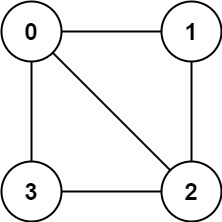Is Graph Bipartite? - BFS
Problem Statement:
There is an undirected graph with n nodes, where each node is numbered between 0 and n - 1. You are given a 2D array graph, where graph[u] is an array of nodes that node u is adjacent to. More formally, for each v in graph[u], there is an undirected edge between node u and node v. The graph has the following properties:
- There are no self-edges (
graph[u]does not containu). - There are no parallel edges (
graph[u]does not contain duplicate values). - If
vis ingraph[u], thenuis ingraph[v](the graph is undirected). - The graph may not be connected, meaning there may be two nodes
uandvsuch that there is no path between them.
A graph is bipartite if the nodes can be partitioned into two independent sets A and B such that every edge in the graph connects a node in set A and a node in set B.
Return true if and only if it is bipartite.
Example 1:

Input: graph = [[1,2,3],[0,2],[0,1,3],[0,2]] Output: false Explanation: There is no way to partition the nodes into two independent sets such that every edge connects a node in one and a node in the other.
Example 2:

Input: graph = [[1,3],[0,2],[1,3],[0,2]]
Output: true
Explanation: We can partition the nodes into two sets: {0, 2} and {1, 3}.
Constraints:
graph.length == n1 <= n <= 1000 <= graph[u].length < n0 <= graph[u][i] <= n - 1graph[u]does not containu.- All the values of
graph[u]are unique. - If
graph[u]containsv, thengraph[v]containsu.
Solution:
The idea is to check if a two-color coloring can be done to the graph. Colors={1,-1} and 0 denotes uncolored. Start with node 0 and traverse by BFS. Then for any other connected component repeat. To do this, we can run for all i from 0 to n and only start doing BFS if it is uncolored.
Note that uncolored = unvisited.
class Solution {
public:
bool isBipartite(vector<vector<int>>& graph)
{
int V = graph.size();
vector<int> colors = vector<int>(V,0);
queue<int> Q;
for (int i=0; i<V; i++)
{
if (colors[i]!=0) continue;
colors[i] = 1;
Q.push(i);
while(!Q.empty())
{
int u = Q.front();
Q.pop();
for (int v: graph[u])
{
if (colors[v]==0)
{
colors[v] = -colors[u];
Q.push(v);
}
else
if (colors[v]==colors[u])
return false;
}
}
}
return true;
}
};